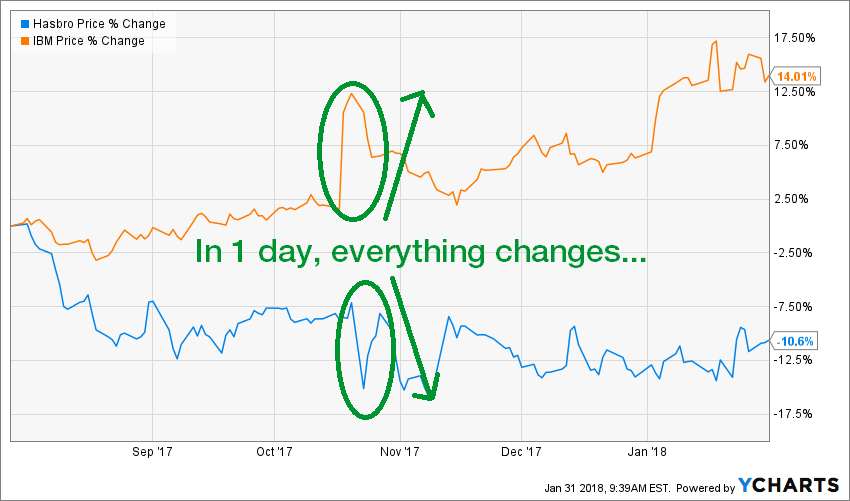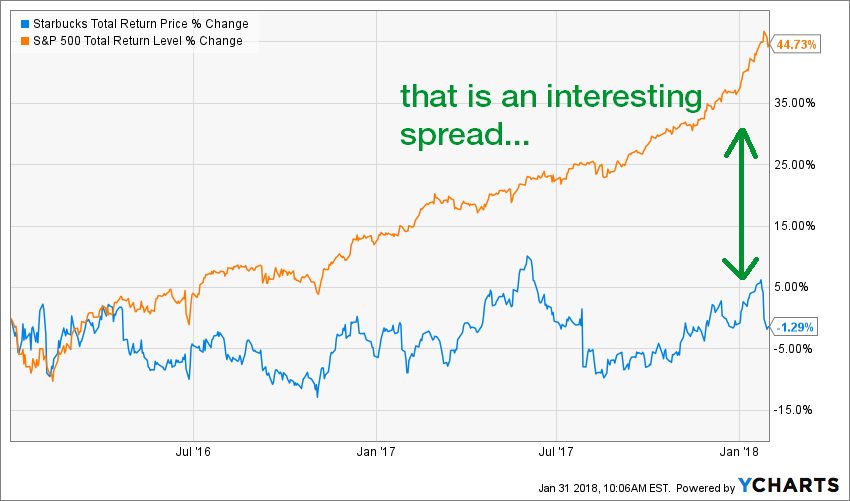
For many, 2018 will be the year of the crash. Those Black Swan Fans have been praying for this over the past 3 to 4 years. They have been sitting on the sideline for so many years that they don’t even look at how much they have lost by not investing. In fact, it’s probably too late for them anyway. Even if the stock market crashes in 2008, it will only get back to the 2013 to 2014 level!
Both for those like me who stayed the course of their investing strategy throughout the years, is there anything you should change for 2018? Is there a special tweak to be made on your strategy? If you are comfortable with your investing strategy, I will tell you upfront to not change anything. But if you are uncertain or if you have not yet developed a real investing strategy, here’s my investing guide for 2018 in three lessons.

Author’s creation
01 Earnings seasons will be rocky – how to prepare
We have seen this phenomenon a few times back in the fall; companies declare strong earnings and their stock jumps by 10% the same day. Fail to please the market and your stock drops like a rock as well. Let’s take IBM (IBM) and Hasbro (HAS) for example.

Source: Ycharts
You can see clearly when both companies disclosed their third quarter. As the market keeps trading at higher levels each week, you are going to see such movement more often. For one reason or another, investors will take profit or jump on an occasion upon earnings reports. Here’s how you can manage volatility.
First, when you hold a stock jumping or dropping – don’t do a thing. When you open your online portfolio and you see a massive movement, the first reflex is to jump on your screen and look at how much you made or lost. Ignore the noise (e.g. price variation) and head toward the company’s earnings press release. This will give you a better idea of what happened, and you will get additional explanation. If you are lucky, you will even have slides to look at in order to grasp what happened with the stock. Then, you take this “new” information and validate your investment thesis. If you haven’t written an investment thesis, here’s an example of what it looks like. If the company meets your investment thesis, keep it. If it doesn’t, drop it. But don’t let the price fluctuation get in the way.
Second, if you don’t hold stocks jumping or dropping – don’t do a thing. A company free falling attracts a few vultures along the way. You may be catching a stock that will rapidly rebound, but keep in mind that catching a falling knife is risky. It’s not because XZY used to trade at $40 and now trades at $31 that it is a good deal. History is filled with companies that never bounced back. General Electric (GE) will become a great example of that. If you don’t hold the stock yet, it’s the perfect timing to take a second look and determine what would be the reasons to buy it (your investment thesis). Don’t start thinking “darn! IBM is up 10%, it’s not the time to buy it anymore.” I have a secret for you; +10% is nothing.
02 +10% is nothing, don’t let your paper profit blur your judgement
I wrote about the triple digit club not too long ago. Those are stocks in my portfolio showing over 100% in return. I’ve encountered many investors in my life that use a “trading rule” such as:
“I’m selling each time a stock jumps by 30% in my portfolio.”
If you follow such rules, you probably emptied your portfolio in the past 3 years. I started managing my children’s school fund (RESP) about 2 to 3 years ago and most of my holdings show over +50%. Is it a reason to sell? Should I cash my profit? I’ll sound like a broken record, but keep your stocks as long as your investment thesis remains.
Do you know the greatest power of investing? It’s called compounded interest. In other words, it’s making money on your own profit. If you let your stocks ride the bull market and hike their dividend year after year, you will capitalize their return and invest profits/dividend into more dividend growth stocks. Forget about the double-digit return, you will get a triple digit total return at one point. 2018 is not the year to take your profit away. 2018 is the year where you continue to make money.
03 Don’t buy just to be part of the gang
One reason why many DIY investors lose money on the market is because they sell when the market is down. The other reason why they lose money is because they buy when it’s high. You keep reading on this blog that “overvalued doesn’t mean anything” and that “waiting on the sideline is not a good idea.” I continue to believe that.
However, if you have been waiting on the sidelines, this doesn’t mean you should invest all your money in the stock market in 2018. Don’t invest to be part of the crowd. Invest because you have found something interesting. Look at a company like Starbucks (SBUX) which has been dead money for the past 2 years.

Source: Ycharts
SBUX is an example of a company that may drag the market but is still interesting. There are definitely other companies in the same situation. They are obviously harder to find today than they were back in 2009, but it doesn’t mean you should not invest your money.
If you have been sitting on the sideline for many years, don’t wait for the next crash. Start entering slowly in the market with careful buys. Don’t try to catch falling knives like GE, and don’t try to catch this month’s market darlings like Walmart (WMT). Both types will burn your hand. However, you can find solid companies that have been ignored by the market’s greed. The DSR buy list is a great place to start looking for stock pick ideas.
Finally – Make sure you know why you invest
When the market is that high for such a long time, I think the most important thing is to remind yourself why you invest. Define your investment plan, build an investing strategy, and get back to this document once in a while. Are you in the market to retire in 20 years or to earn retirement revenues in the next 6 months? Are you funding your young children’s future education or are you buying a house in 2 years? Do you want to beat the market or meet your investing plan? For the last question, I hope you will focus on the latter…
The post My Investing Guide for 2018 appeared first on The Dividend Guy Blog.
